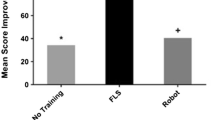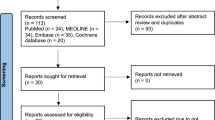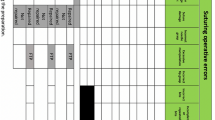Abstract
Background: The incorporation of new devices into surgical practice often requires that surgeons acquire and master new skills. We studied the learning curve for intracorporeal knot tying in robotic surgery. Methods: We developed an objective scoring system to evaluate knot tying and tested eight attending surgeons during 3 weeks of training on a surgical robot. Each performed intracorporeal knot tying tasks both before and after robotic skills training. These performances were compared to their laparoscopic knots and analyzed to determine and define skill improvement. Results: Baseline laparoscopic knot completion took 140 sec (range, 47–432), with a mean composite score of 77 (100 possible), whereas robotic knot tying took 390 sec, with a mean composite score of 40. After initial robotic training, times decreased by 65% to 139 sec and scores increased to 71. With more training, completion times and composite scores were improved and errors were reduced. Conclusion: Like any new technology, surgical robotics requires dedicated training to achieve mastery. Initially, even experienced laparoscopists may register an inferior performance. However, after adequate training, surgeons can exceed their laparoscopic performance, completing intracorporeal knots better and faster using robotics.





Similar content being viewed by others
References
GH Ballantyne (2002) ArticleTitleThe pitfalls of laparoscopic surgery: challenges for robotics and telerobotic surgery. Surg Laparosc Endosc Percutan Tech 12 1–5 Occurrence Handle12008756
AM Derossis GM Fried M Abrahamowicz HH Sigman JS Barkun JL Meakins (1998) ArticleTitleDevelopment of a model for training and evaluation of laparoscopic skills. Am J Surg 175 482–487 Occurrence Handle10.1016/S0002-9610(98)00080-4 Occurrence Handle1:STN:280:DyaK1czgslOjuw%3D%3D Occurrence Handle9645777
TR Eubanks RH Clements D Pohl N Williams DC Schaad S Horgan C Pellegrini (1999) ArticleTitleAn objective scoring system for laparoscopic cholecystectomy. J Am Coll Surg 189 566–574 Occurrence Handle10.1016/S1072-7515(99)00218-5 Occurrence Handle1:STN:280:DC%2BD3c%2FlsFGisg%3D%3D Occurrence Handle10589593
A Garcia-Ruiz M Gagner JH Miller CP Steiner JF Hahn (1998) ArticleTitleManual vs robotically assisted laparoscopic surgery in the performance of basic manipulation and suturing tasks. Arch Surg 133 957–961 Occurrence Handle10.1001/archsurg.133.9.957 Occurrence Handle1:STN:280:DyaK1cvitVaktA%3D%3D Occurrence Handle9749847
LT Kohn JM Corrigan M Donaldson (1999) To err is human: building a safer health system. Institute of Medicine Washington (DC)
MJ Mack (2001) ArticleTitleMinimally invasive and robotic surgery. JAMA 285 568–572 Occurrence Handle10.1001/jama.285.5.568 Occurrence Handle1:STN:280:DC%2BD3M7kvFKisw%3D%3D Occurrence Handle11176860
MJ Moore CL Bennett (1995) ArticleTitleThe learning curve for laparoscopic cholecystectomy. The Southern Surgeons Club. Am J Surg 170 55–59 Occurrence Handle10.1016/S0002-9610(99)80252-9 Occurrence Handle1:STN:280:ByqA3MzotVc%3D Occurrence Handle7793496
D Nio WA Bemelman KT Boer MS Dunker DJ Gouma TM Gulik (2002) ArticleTitleEfficiency of manual versus robotical (Zeus) assist laparoscopic surgery in the performance of standardized tasks. Surg Endosc 16 412–415 Occurrence Handle10.1007/s00464-001-9012-y Occurrence Handle1:STN:280:DC%2BD387psFSitg%3D%3D Occurrence Handle11928018
JC Rosser LE Rosser RS Savalgi (1997) ArticleTitleSkill acquisition and assessment for laparoscopic surgery. Arch Surg 132 200–204 Occurrence Handle1:STN:280:ByiC1MvkvV0%3D Occurrence Handle9041927
CM Schlachta J Mamazza PA Seshadri M Cadeddu R Gregoire EC Poulin (2001) ArticleTitleDefining a learning curve for laparoscopic colorectal resections. Dis Colon Rectum 44 217–222 Occurrence Handle1:STN:280:DC%2BD3M7ot1Sksg%3D%3D Occurrence Handle11227938
NE Seymour AG Gallagher SA Roman MK O’Brien VK Bansal DK Andersen RM Satava (2002) ArticleTitleVirtual reality training improves operating room performance: results of a randomized, double-blinded study. Ann Surg 236 458–463 Occurrence Handle10.1097/00000658-200210000-00008 Occurrence Handle12368674
NJ Soper JG Hunter (1992) ArticleTitleSuturing and knot tying in laparoscopy. Surg Clin North Am 72 1139–1152
Strayer MP, Krause KR, Dalstrom DJ, Melvin WS (2001) Computer enhanced “robotic” telesurgery versus standard laparoscopy: performance on a skills test [Abstract]. Annual meeting of the Society of American Gastrointestinal Endoscopic Surgeons (SAGES), St. Louis, MO, USA, April 2001
Z Szabo J Hunter G Berci J Sackier A Cuschieri (1994) ArticleTitleAnalysis of surgical movements during suturing in laparoscopy. Endosc Surg Allied Technol 2 55–61 Occurrence Handle1:STN:280:ByuA28zktl0%3D Occurrence Handle8081917
P Yohannes P Rotariu P Pinto AD Smith BR Lee (2002) ArticleTitleComparison of robotic versus laparoscopic skills: is there a difference in the learning curve? Urology 60 39–45 Occurrence Handle10.1016/S0090-4295(02)01717-X
Acknowledgments
This study was supported in part by the US Surgical Corporation, a division of Tyco Healthcare, and by Computer Motion, Inc.
Author information
Authors and Affiliations
Corresponding author
Rights and permissions
About this article
Cite this article
Chang, L., Satava, R., Pellegrini, C. et al. Robotic surgery: identifying the learning curve through objective measurement of skill. Surg Endosc 17, 1744–1748 (2003). https://doi.org/10.1007/s00464-003-8813-6
Received:
Accepted:
Published:
Issue Date:
DOI: https://doi.org/10.1007/s00464-003-8813-6




